Club Night Report
Wednesday 13th April 2016
Club Night Report for 13th April 2016 - observations by Vernon Hughes
Our visiting demonstrator, Mark Hancock (www.markhancock.co.uk), gave a very good account of himself in March 2014 (see Harry Rock's comprehensive review of that event). Reading it first is strongly recommended to pick up on the distinctly visible consistency of Mark's valuable advice on subjects he clearly holds dear. These include the importance of safe practice, the value to be gained from the study of tree structure and the position therein from which the wood to be turned is sourced, the need to understand the nature of micro-cellular tree structure, his pronounced preference for turning freshly cut timber, etc.
 |
 |
 |
 |
 |
 |
 |
 |
Any preliminary fears that we were being deluged with goblet presentations (three in eight months) were promptly dispelled by evidence that Mark's crooked versions are distinctly different from anything seen previously. (Line one of my notes includes 'Gee Whizz!') As in 2014 Mark advised that this evening's piece would not be completed to gallery standard. The blank for the evening's main project turned out to be a very wet piece of Silver Birch of dimensions say 12" long by more than 2.5" square section. At this point he repeated the tip given in 2014 that placing a washer or plumbing olive onto the point of a tail centre has the effect of converting it into a ring centre. This was also the moment chosen for his firmly delivered main piece of safety advice. Safety spectacles are not adequate facial protection, even for the eyes alone. A full-face visor with polycarbonate shield should always be worn. There is a history of serious accidents in lathe work. He also focussed on the correct definition of the spindle roughing gouge to emphasise that its use must be restricted to parallel grain work! He then repeated his 2014 explanation of the reasons for thinking of the piece of wood to be turned as simply either parallel or cross grain.
Turning then began in earnest with the blank being roughed down and a spigot prepared at the tailstock end. Ticker-tape shavings of great length hurtled from the tool edge before slowing and almost floating groundwards. The blank was tapered gently towards the headstock end before being reversed and mounted in the selected chuck (done off-lathe to achieve perfect grip-strength), and the tailstock was removed. External rough shaping of the tiny goblet (cup) was performed whilst retaining full strength in the body of the blank. Mark then led group contemplation of the correct approach to hollowing including the respective merits of working from outside to in or vice versa whilst thinking about cutting with the grain. He concluded that in this case which either way suits the turner will be OK and he started from outside in. He added that it also pays to check what the shavings are telling you during such work. In this case the wet timber came out sweetly and it was soon time to bring up his purpose-perfect light to be beamed into the cup of the goblet while external shaping and wall thickness were perfected. The light effect achieved was a show in itself with dramatic colours appearing to please the eye. There was a word of caution; when light is being used as a measuring tool white light must never be seen!
Mark then talked for some minutes about various aspects of timber and its management, and his approach to and opinions about it. Green timber is cheap and easy to turn, it is not dusty or noisy and the fibres are still open, whereas they become compressed in the drying process. This effect even causes wall thickness to decrease as drying occurs. He likes to work with timber from a tree the day after it has been felled. He talked of the need for turners to learn how timber distorts (not a difficult subject) and that too many understand wood insufficiently. An exceptionally thoughtful and economically expressed observation was that cracks occur in drying where mass is inconsistent. The stability obtained by the process of quarter-sawing timber was mentioned, as was the oval appearance of thin-walled objects. All shape changes can be predicted if you understand the structure of the wood.
 |
 |
 |
 |
 |
 |
 |
 |
Returning to the goblet and after final shaping of the cup, work then started on the stem, which Mark observed (almost tongue-in-cheek?) must not be too thin because it had to support the cup. Various small sized tools were brought into play including a mini-skew. As seen in other goblet demonstrations the technique with stems is to proceed in short steps below the cup, each short length being perfected before proceeding to the next. The unworked body of the blank is kept at full size to retain strength and support for as long as possible. Although not used on this occasion mention was made that a golf ball can be placed between a tail centre and the mouth of a cup to give additional support, but he would not attempt this with dry timber. Mark chose the opportunity to opine that kiln drying is overdone and that it 'kills the life in timber'. He added that if timber wobbles it is telling you something; it should stay straight if timber selection is right. He then switched to the sharpening of skews and the fact that he hones them to achieve the razor-sharp edges critical in this type of fine work. They are never taken to the grinder; this would result in a burr on one side of the edge. As work on the stem progressed with occasional curled finger support Mark confessed that he had once made a captive ring that was too large and it passed over the goblet cup! Its making should be kept till a late stage for strength, but eventually roughing down can be taken to a suitable smaller size so that work on the ring can be started without risk of 'oversize'. A flat was made with a parting tool and after creating a space behind the ring position the flat was converted to a bead. Various possibilities for creating captive ring tools were then discussed, including carefully ground 'Allen' keys, before he applied his bent (carefully selected) nail tool. A small carving tool was used to clean up the inside of the ring, the Birch having produced a rather woolly surface. It was emphasised at this stage that a knot-free stem was essential to the bending process that was to come after the coffee-break. Mark mentioned the hectic scurrying that occurs when steam-bending of larger (knot-free) strips of Ash are shaped in Windsor Chair making for example, and asked if anyone had experience of that. Was I alone in answering 'yes'? Note though that the scurrying is disciplined and purposeful!
Before taking us into the bending phase Mark demonstrated a neat way of 'sanding' the inside surface of the captive ring by wrapping and taping abrasive round the stem and rotating the ring by hand over it. In the process of parting off the goblet he mentioned the 'Tormek' way of grinding parting tools. This involves additional presentations to produce sharp cutting edges behind the tip. These are particularly useful for producing a fine finish on the end of the turned piece during parting off. The base of the goblet was slightly undercut.
 |
 |
 |
 |
 |
 |
 |
 |
Then came the entertainment of bending the stem. Examination of the base was the first step to establish the plane of least resistance, recognising that there would be a partial folding effect during bending and this involves both compression and stretching. A sketch was drawn to show how the annular rings lay in the cross-section of the stem. The decision was straightforward in this instance and the stem was laid on a hard flat block so that a very small cabinet scraper could be applied to convert round to flat. Mark emphasised that very careful timber selection is always crucial in this work. It must be knot and grain-variation free! An unexposed blind knot caused during growth when a new branchlet has failed to develop would be an unfortunate and fatal flaw. Flattening was carried out to the maximum and Mark advised that the finish should be as even as possible. He then produced a musical instrument maker's heated former for use in bending. The goblet stem was wetted frequently during the process and he explained that in small work pliability lasts for longer than might be expected. (As an aside Mark mentioned that in the event of a scald immediate dabbing with Lavender Oil will prove highly beneficial). This stem was bent very successfully and examples of other shapes achieved were held up as well for viewing. As a Hereford boy originally I was particularly pleased to see that the 'Hereford' design has a cup rotated through 360 degrees in a complete loop so that its mouth faced logically upwards. The rival 'Worcester' was a dreamier shape. Mark gave some advice on methods of stabilising the base of these variously crooked goblets when displayed. He advised that timbers such as Holly, Birch, Beech, Sycamore and others would all be suitable for the work BUT under no circumstances should the long fibres contain flaws or breaks. (NOTE: For the benefit of those newer to turning and less familiar with the characteristics of wood it seems worth explaining that trees, in common with all living things, have a microscopic cellular structure. These can be thought of as forming long strands like a bunch of drinking straws which are held together by lateral strands of cells (rays) spraying out like radii from the centre (medulla) of the tree and its limbs. When exposed by disciplined quarter-sawing these rays give the beautiful 'figure' found in quality timber, especially in Oak but noticeable in others such as London Plane and Beech etc. The long strands must remain intact to retain the flexible quality insisted upon by Mark and other benders of wood.)
With the project completed successfully the evening came to a close and Arthur observed that 'we had seen something new tonight!' The round of applause for a demonstrator of exceptional skill in word and deed was thoroughly well earned, even though the popularity of such goblet making in North Wilts has yet to be ascertained.
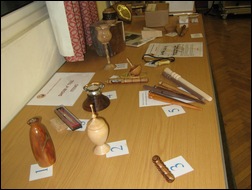 |
The Show and Tell theme this month was: A "Shoestring Turned Item" - this was well supported with many creative entries...
| This month's Show and Tell winner is Dave Groves with a lidded goblet in rescued beech. |
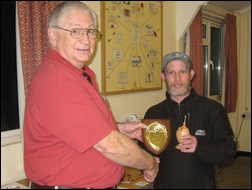 |
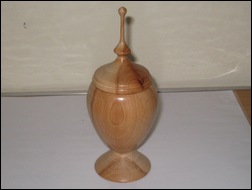 |
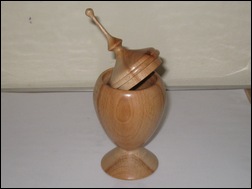 |
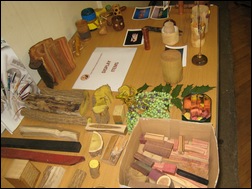 |
